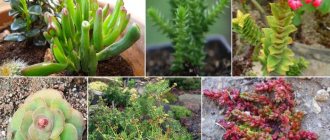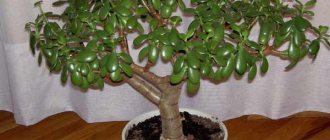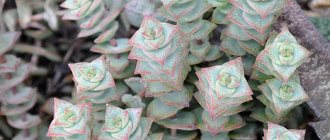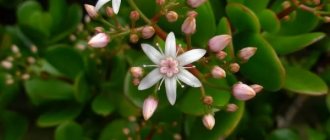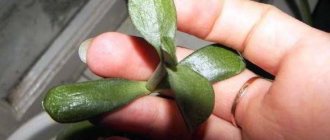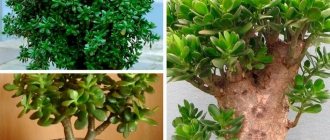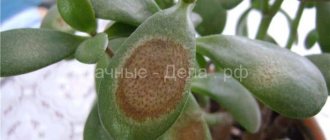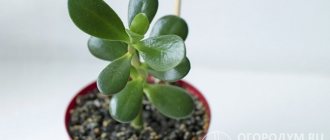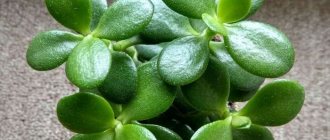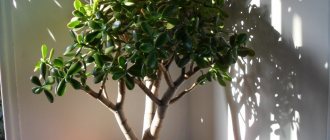The ovoid Crassula (lat. Crassula ovata) belongs to the Crassula family. The plant develops as a tree-like shrub and can reach two meters in height. Its lush green leaves are pleasing to the eye and filter pollutants from indoor air. Grown as a houseplant with the promising name "money tree", but can definitely spend the summer outdoors. It is easy to care for, hardy and suitable for beginners.
Description
Crassula ovate is a semi-herbaceous plant that came to our windowsills from South Africa. Included in the TOP 5 best flowers for home growing.
Crassula ovate is a large, branching, compact and evergreen succulent plant. The shape of the bush is round. The plant blooms only in winter and spring.
Other characteristics of the plant:
- Stem . Thick, up to 20 cm in circumference. At the base it is knotty, from soft brown to gray.
- Branches. Small, proportionate, fleshy, their color is green with a slight gray tint, naked. If you look closely, you can see scars from fallen leaves. In mature plants, the bark peels off, forming brown horizontal ribbons.
- Leaves. Length 3-9 cm, width maximum 4 cm, shape – ovoid. The leaves are glossy, fleshy, flat, the tip is slightly pointed. Their main color is green, but depending on the variety, the shade can vary from gray to pale red. Near the edge there are nectar glands, their position is in rows, but randomly, found on both the upper and lower surfaces of the leaf.
- Peduncle. The inflorescence is corymbose-paniculate, apical, round in shape, can be dense or loose, but always with a large number of small flowers.
- Flowers. They have a star-shaped shape, their color is soft pink, there are 5 petals, and the aroma is unobtrusive. The sepals are broadly triangular, fleshy and have sharp tips. The corolla is white or slightly pinkish. The petals are oblong, sharp, spreading. Stamen filaments are about 5 mm with purple anthers. Pistil 2-3 mm long, thread-like.
- Fruits and seeds. The fruits of the Crassula ovoid are small capsules measuring 3-3.25 mm, each of which contains a large number of small seeds.
Growing conditions for indoor oval Crassula
Crassula oval is a light-loving plant; the soft but bright regime of eastern and western window sills is considered ideal for it. The interior suffers from a lack of light. In direct sun, especially on southern windows, it can turn yellow or surprise with the reddishness of the leaves, but in general the plant is quite stable. The fancier the variety, the more light-sensitive and sun-fearing it is.
In winter, to preserve the leaves, it is better to adjust the lighting by moving the fat plant to more illuminated places.
Wintering of fat women should ideally take place in cool conditions, with slightly lower temperatures (from 12 to 18 degrees), but even at normal room temperatures, especially if the lighting has been adjusted, they will not suffer. Pulling out or shedding leaves threatens fat plants only in the heat, close to radiators, in the shade, and even then in the spring they quickly recover.
In the summer, the oval carassa can be moved to the balcony, to the garden, or left in the room. It cannot be called the most sensitive to drafts, but it is better to protect the plant from cold ventilation. But the plant does not like air conditioners and radiators.
Popular varieties of ovoid Crassula
Crassula ovata is a type of succulent plant that has its own varieties, of which there are more than 300. Not all of them are planted on windowsills, but only those that are especially popular. They are small in size, so they can be found in offices and entrance halls.
Ovata minor
The variety was bred by breeders. Distinctive features are compact size (about 50 cm) and slow growth. The trunk is erect, from which shoots extend. The leaves are small, 1.5 cm long and 1 cm wide. Variegated. Color – dark green with bright red edging.
If the plant is in a well-lit place, then you can enjoy all the richness of the color. Typically, Crassula Minor is used to create spectacular mini-gardens in residential settings.
Hobbit
A small succulent plant, the height of which is maximum 90 cm, the width of the bush is about 60 cm. The shape of the leaves is unusual - finger-shaped, tubular with concave tips, their length is up to 5 cm.
The color of the leaves can vary from soft green to rich green, the tips always have a red tint, which can be intensified by exposure to sunlight and low temperatures.
Ovata sunset
A variegated variety of Crassula ovata. This is a compact tree with a lush crown. The leaves are colored in several tones. In the middle - green, closer to the edges - creamy yellow.
In order for the plant to look as decorative as possible and be able to reveal all its flowering characteristics, it must be located in a well-lit place.
Gollum
The plant appeared by mixing Crassula Ovata and Milk. The leaves are in the form of an oblong tube, with expansion noted at the apex. Because of this shape, the leaves are called “Shrek ears.” Their color is green, with a purple rim along the edge.
Crassula Gollum grows very slowly, even in adulthood the maximum height is 50 cm.
The flower is often used to create bonsai. This is because the plant is compact and capable of independently forming an attractive crown.
Short review
Family: Crassulaceae (lat. Crassulaceae); Name: Crassula ovata (lat. Crassula ovata); Trivial names: Money tree, tree of luck, tree of friendship; Succulent erect plant, highly branched shrub; Native to Southern and Eastern Africa and Madagascar; Height in cultivation: from 50 to 130 cm, rarely higher. Fleshy, oval-shaped evergreen leaves with a smooth reddish edge; Small white or pink flowers; Flowering time: late winter or early spring; First flowering: after 10 years and later; Prefers a warm, sunny place (avoid direct sunlight); It is not a frost-resistant plant. Grow at a temperature not lower than 5 °C; Prefers slightly acidic soils; The plant is not toxic to humans and animals.
Rules for planting and transplanting
Planting Crassula ovoid at home is quite simple. The procedure is standard, but there are several rules:
- at the bottom of the pot, which is chosen specifically for the size of the seedling, there must be a drainage layer;
- immediately after planting, the plant needs to be watered;
- you should work carefully, as there is a risk of damaging the root system.
The money tree should be replanted regularly. This is a particularly important procedure for young specimens, since the plant grows rapidly and the roots require more space. It is recommended to replant once every 2-3 years.
The procedure should only be carried out in spring or summer. Winter is not a good time, because the plant is in a dormant stage and practically does not grow. If roots or other components are damaged, the tree may not recover.
Procedure for replanting a succulent:
- Place a new layer of drainage at the bottom of the pot.
- Add some soil.
- Remove the earthen lump from the roots.
- Insert the plant into the new soil while maintaining the depth.
- Press the fit firmly.
- Add the required amount of substrate.
After transplanting, place the plant in a partially shaded area for 3 weeks. Once the time is up (after 4 weeks), start watering the tree moderately.
How to care for ovoid crassula?
Crassula ovate is a succulent that does not require special skills from the gardener in the field of care and maintenance of indoor plants. It is enough to select the right comfortable living conditions for the tree once and periodically carry out a series of simple procedures.
Crassula Ovata is native to a hot and arid continent, so it can survive even in the harshest conditions.
How to choose a pot and substrate?
When choosing a flowerpot for planting Crassula ovata, you need to look at the size of the root system. Usually it is much smaller than the ground part. The root develops in breadth and not in depth, so it is required that the pot has a 4 cm layer of drainage. This can be played by:
- pebbles;
- expanded clay;
- debris from bricks or ceramic materials;
- gravel or fine crushed stone.
It is better not to consider pots made of plastic or other lightweight materials. The plant may grow too large for the pot and it may tip over, damaging the tree. The optimal solution is a shallow container made of clay.
It is believed that the money tree grows best in pots of dark colors: brown, black, dark red. They imitate the shade of the soil. But this statement has not been proven.
It is preferable to use a mixture of 3 parts soil, 1 part coarse sand or perlite as soil for planting succulents.
Which place is better?
It is best to keep a pot with Crassula ovoid in a place well lit by the sun. The plant also reacts positively to dark areas. The ideal solution for wood is a window sill facing East.
Several rules for choosing the location of a succulent:
- You can place a flower on the south side, but not in the summer. The scorching rays of the sun can cause burns on the leaves, which will first darken and fall off.
- The northwestern direction can be chosen only in one case - the plant is standing on a windowsill in a high-rise building without close proximity to shading elements.
- The room must have a powerful ventilation system. The fat plant needs fresh air, this is the only way the plant will bloom beautifully and develop properly. In addition, air circulation helps keep humidity within normal limits.
- Even acceptable lighting needs to be dosed by turning the pot with different sides to the luminary.
Humidity and temperature
You need to approach the selection of temperature conditions responsibly and take into account several rules:
- during the period of intensive growth, the plant needs heat - about +25 degrees;
- in winter – cooler conditions, no more than +12 degrees.
Crassula ovata grows well in a room with moderate humidity. A high rate can cause suppuration of the stem and leaves, and too dry air will cause leaves to fall off.
How to water?
During the spring and summer, the succulent tree needs regular watering. But it is unacceptable to over-moisten the soil in the pot. Otherwise, the process of rotting of the root system will begin, which will lead to the death of the plant.
Watering is started when the soil is 2/3 dry.
When cold weather sets in, the fat plant is transferred to a cool room. The plant is at a dormant stage at this time and does not need to be watered. Otherwise, the combination of cold and soil moisture will lead to the death of the flower.
A complete refusal to water and reducing it to minimum volumes in winter will not have a negative effect on the plant. The fleshy leaves contain enough moisture to survive dormancy without additional water.
If the leaves begin to wrinkle in winter, this indicates that the plant needs to be watered immediately.
Feeding and fertilizer
When the weather remains warm on the street and on the windowsill, the Oval Crassula should be fed once a month. Subtleties of fertilizing:
- Before starting the procedure, you need to water;
- substances are introduced into the soil one day after it is moistened;
- You can use specialized compounds for succulents and cacti;
- mullein, which has been aged for 1 month and diluted in a ratio of 1:10, can serve as a top dressing.
Reproduction
You can propagate Crassula ovata in several ways, which are equally promising:
- Stem cuttings. To propagate the crassula by a similar method in the spring, at the end of flowering, fresh, particularly green shoots located at the end of the branch are cut off. How to proceed:
- In spring, trim the tips of the shoots, their length is from 10 to 15 cm;
- Break off the leaves at the bottom;
- Leave the sections to dry, 2 days is enough.
- Place the cutting in a glass of water. More than 50% of the section must be immersed in liquid. This is necessary for root germination.
- Make sure the soil is always moist.
- Leaf cuttings. This option is relevant only in one case - when you do not want to deprive the plant of shoots 15 cm long or to obtain a large number of new young succulents. One feature worth considering is that the roots take much longer to form and grow. How to propagate a money tree correctly in this case:
- Break off or cut off the fleshiest and greenest leaf from the shoot.
- Leave the wound to dry for 3 days.
- Fill the pot with substrate.
- Place the cutting about 1cm deep into moist soil.
- Place a match as a support. At the base of the leaf cutting, a miniature tree grows, developing its own root system. Once it has formed to a few cm (about 10), cut the leaf using an alcohol-treated razor blade.
How to make a money tree bloom
In indoor conditions, it takes at least 10 years for the first flowers to appear on a money tree. If this ornamental plant is still keeping its small white flowers under lock and key, you can use the following strategy to get the process started.
- from the beginning of September, gradually reduce the amount of irrigation water to an absolute minimum;
- stop supplying nutrients;
- Move the money tree to a cool, bright place.
Temperatures below 15°C but above 5°C are the main requirement for flower formation. Combined with a near-dry substrate, you simulate the South African cool, dry season when the money tree begins to bloom. A cozy and warm living room is not the right place to enjoy winter blooms. However, on the bright windowsill of an unheated bedroom, nothing will prevent the appearance of beautiful flowers.
Difficulties in growing the species
Usually, there are no problems with growing an ovoid crassula if you take into account all the characteristics of the plant and adhere to the basic rules. If the procedure is neglected, a number of problems may arise:
- The money tree stopped growing after transplantation. The procedure is carried out using a larger pot.
- It is not possible to maintain the compact size of the plant. In this case, when replanting, you need to use the same pot, and not more. The roots are cut directly above the scars of old leaves. Then new leaves will begin to grow from this place.
- The roots rot. It is necessary to normalize watering of the plant, check and adjust the temperature and air humidity.
- The leaves wrinkle. Most likely the cause was the location of the pot near the radiator of the battery.
- The leaves have turned brown. This indicates a lack of moisture.
The winter months for the money tree are considered to be from October to March. Crassula oval tolerates well, if you take into account several points:
- the plant requires a dry, calm and cool climate;
- good temperature indicators from 5 to 13 degrees with a + mark;
- watering stops in winter;
- During the dormant period, the plant is not fertilized.
Varietal diversity of Crassula ovata
The money tree today offers a considerable selection of unusual varieties:
- original thick-trunked bushes of the Oblikva series with pointed lanceolate striped leaves;
- small-leaved varieties of the “Compact” series;
- miniature blushing bushes of the “Minor” variety;
- bizarre leaves of the Hobbit variety fused at the base;
- variegated variegated varieties (for example, “Tricolor”, “Sunset”).
Special varieties are becoming more and more popular. You should choose them according to your taste, because they are similar in character to the base plant.
Oval Crassula (Crassula ovata), variety “Minor”. © José Leocadio Rejas Ma
Crassula ovata, Hobbit variety. © sakyurek
Oval Crassula (Crassula ovata), variety “Tricolor”. © gardentags
Formation of a tree
It is easy to grow a bonsai using an egg-shaped succulent. It lends itself well to shaping. Usually the procedure is carried out in the spring. This is necessary for the plant to get stronger. How to form a fat plant depends on the personal preferences of the grower.
A decorative money tree can be made into a fluffy ball, a tall tree, or an original plant with curved stems in an exotic style.
It is worth considering the fact that the succulent sheds its leaves from below, exposing the brown stem. The money tree should be pruned 1 or 2 times a year. Things to remember:
- a sunny day is chosen in March;
- shoots that are too long are shortened to the desired length;
- place the scissors just above a pair of healthy leaves;
- after pruning there should be no stumps left.
Crassula is a non-poisonous plant, so you can operate without gloves; the scissors must be thoroughly disinfected and well sharpened. The smoother the cut, the lower the risk of infecting the plant.
After pruning, the plant will form more densely. Always make straight cuts and cut only along thin grooves, such as where a leaf has fallen off.
Similar flowers
- Tree Crassula (Crassula arborescens) is a species from the genus Crassula, which is sometimes confused with Oval Crassula due to the similar structure of the trunk and leaves. But the leaves of the tree-shaped Crassula are more rounded than those of the ovate, and their color is gray-silver.
- Echeveria or Echeveria is a genus of perennial succulent plants of the Crassulaceae family. It has fleshy leaves with red tips similar to Crassula leaves, but unlike Crassula it is a herbaceous plant.
- Cotyledon is a genus of plants in the Crassulaceae family. Its leaves are similar to those of Crassula and have a similar red edge.
- Pachyphytum is a genus of perennial succulents of the Crassulaceae family. The leaves of plants of this genus are as fleshy as those of the Crassula.
- Aeonium is a genus of plants in the Crassulaceae family. Just like the oval crassula, it has fleshy leaves, but of a different shape, and is a subshrub.
Crassula ovata is a beautiful plant that anyone can care for, which undoubtedly makes it the best choice of indoor flower even for those who are not an avid gardener. And the decorative nature of its leaves will delight the eye at any time of the year.
Also check out other Crassula species such as Crassula Perforata, Silver Crassula, Mossula and Buddha Temple.
Diseases and pests
If you regularly make mistakes when maintaining a money tree, it can get sick. The following will appear:
- mealy or root bug;
- aphid;
- sciarids;
- flower midges;
- wine weevil.
Specialized means of different effects or folk methods will help get rid of parasites, but the first thing to do is to eliminate the cause of the disease and replace the soil in the pot, which has been treated with fungicides.
When choosing an insecticide, you should check whether it is suitable for succulents. Before use, carefully read the instructions, otherwise you may harm the plant.
Reproduction of the Oval Crassula
This type of Crassula takes root amazingly easily. Even accidentally fallen leaves often begin to germinate right in the pot, not to mention leaf cuttings with aerial roots, apical and stem cuttings. You can root the shoots or leaves of Crassula oval in water, sand, or a regular substrate. The main thing is to dry the cuts and use disinfected soil.
It is not necessary to cover the cuttings with a cap; light soil moisture or regular water changes are sufficient. Crassula cuttings take root very quickly, in 2-4 weeks. And you can take cuttings from a money tree literally at any time of the year.
You can grow Crassula oval from seeds, but vegetative propagation is much easier. And you won’t have to wait for many years for results.
